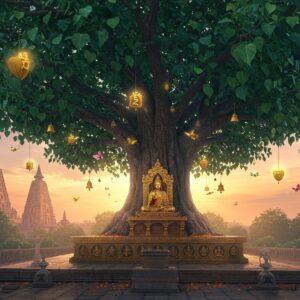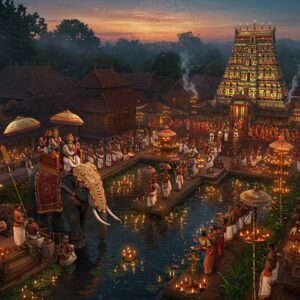Embark on a Spiritual Odyssey to Thiruvazhmarban Temple

Imagine a place where time whispers tales of devotion, where legends intertwine with the present. Welcome to the sacred Thiruvazhmarban Temple, nestled in the heart of Thiruppathisaram, Tamil Nadu. Also known as Sri Kuralappa Perumal Temple, this revered sanctuary holds a special place among the 108 Divya Desams – the sacred abodes of Lord Vishnu, glorified in the hymns of the Alvar saints. Prepare to be captivated by a rich tapestry of culture, history, and profound spirituality.
Delving into the Historical Tapestry of Thiruvazhmarban Temple
The history of Thiruvazhmarban Temple unfolds like a timeless epic. Inscriptions etched in stone reveal glimpses of its past. The earliest, dating back to 1139 CE, speaks of a donation by Natesan Chetti, a testament to the temple’s enduring significance. Subsequent inscriptions from 1613 and 1785 CE further chronicle the temple’s story through recorded offerings. King Thirumalai Nayak (1623-59 CE) is believed to have graced the temple with the stepped tank, a serene space for reflection. Through the ages, the temple has also been known as Thiruvanparisaram, a name that echoes through time.
Whispers of Legends and Lore
Legends and folklore add a mystical dimension to the temple’s aura. It is believed that the Saptarishis, the seven celestial sages, once graced this sacred ground with their presence, offering their worship to Lord Vishnu. Another captivating legend recounts the tale of King Kulasekara Alwar. After a victorious campaign, he stumbled upon his lost horse grazing peacefully near the Soma Theertham, the temple tank. He bathed in the sacred waters and offered prayers to Lord Vishnu, feeling a sense of profound rejuvenation. Inspired by this divine experience, he is said to have built the temple, naming it Thiruvanparisaram, where “Pari” in Tamil signifies “horse.” The name Thiruvazhmarban itself carries deep meaning – “Thiru” denoting respect, “Vazh” signifying life, and “Marban” meaning heart. Together, they paint a beautiful image of Vishnu holding Lakshmi in his heart.
Architectural Splendor: A Symphony in Stone
The architectural grandeur of Thiruvazhmarban Temple is a testament to the Dravidian artistry. Spanning approximately 2 acres, the temple boasts a magnificent five-tiered gopuram that reaches towards the heavens. Within the central shrine, Lord Thiruvazhmarban resides in a serene seated posture. Unlike many other temples, there isn’t a separate shrine for Lakshmi Devi, as she is believed to eternally reside within Vishnu’s heart. The deity’s image, crafted from a unique blend of lime and granite, is surrounded by depictions of the Saptarishis, along with revered figures like Rama, Lakshmana, and Sita. The second precinct houses shrines dedicated to Garuda, Anjaneya, Ramanuja, Vedanta Desika, and the Azhwars, each adding to the spiritual richness of the temple. The festival deity, fashioned from Panchaloha (a five-metal alloy), is brought forth during special rituals and ceremonies, radiating divine energy.
Rituals and Festivals: A Celebration of Faith
Thiruvazhmarban Temple comes alive with vibrant festivals and sacred rituals throughout the year. The Chittirai Brahmotsavam (April-May) is a grand celebration, filled with colorful processions and devotional fervor. The Aadi Swati festival (July-August), dedicated to Kulasekara Alwar, is another important occasion. Navaratri (September-October) and Vaikunta Ekadasi (December-January) draw devotees from near and far, seeking blessings and spiritual solace. The Aaraatu ceremony on the Poosa star day in the month of Masi (February-March) adds a unique touch to the temple’s festive calendar.
Planning Your Pilgrimage: A Guide for Devotees
If you’re planning a visit to Thiruvazhmarban Temple, here are a few tips to enhance your spiritual journey:
- Best Time to Visit: The festival seasons offer an immersive experience, but the temple welcomes devotees year-round. Consider the weather and plan accordingly.
- Immerse yourself in the rich culture and vibrant atmosphere during temple festivals, but be prepared for larger crowds.
- Nearby Attractions: Explore the cultural heritage sites surrounding Thiruppathisaram to enrich your experience.
- Discover the hidden gems surrounding the temple—other historical sites and natural wonders waiting to be explored.
- Accommodation: A range of accommodation options are available to suit various budgets and preferences.
- Choose from a variety of accommodations, from budget-friendly guesthouses to comfortable hotels, ensuring a pleasant stay during your pilgrimage.
- Respectful Attire: Dress modestly and respectfully when visiting the temple. Traditional attire is always appreciated.
- Traditional attire adds to the reverence of your visit and is deeply appreciated within the temple atmosphere.
- Ritual Participation: Participate in the rituals and ceremonies respectfully to deepen your connection with the divine.
- By participating in the rituals, you deepen your spiritual experience and connect with the temple’s rich heritage.
Embrace the spirit of responsible tourism by respecting the temple’s serene atmosphere and supporting local communities.
Poojn.in: Your Companion on this Spiritual Journey
Preparing for your visit to Thiruvazhmarban Temple? Poojn.in is here to assist you. As India’s leading provider of puja samagri and spiritual products, we offer a wide range of authentic items to enhance your devotional experience. From pure cotton vastram and dhoti for temple visits to traditional brass lamps (vilakku) for aarti, we have everything you need to express your devotion with reverence. You’ll also find fresh coconuts, bananas, pure camphor, and sambrani, all essential for traditional offerings. Explore our complete puja sets, including ready-to-use thalis, brass vessels for abhishekam, pure cotton wicks, and natural kumkum and chandanam.
Poojn.in guarantees the authenticity and purity of its products. We take pride in sourcing our items according to traditional specifications, ensuring they are temple-grade and packaged with utmost care. Our online store (www.poojn.in) offers pan-India delivery, with special attention given to fragile items.
Have questions about specific temple rituals or need guidance on selecting the right puja items? Don’t hesitate to contact our dedicated customer service team at 03369029784 or WhatsApp us at 9476142738.
*Note: For specific temple rituals, it’s always best to confirm the requirements with temple authorities beforehand.*
Embrace the Divine Aura of Thiruvazhmarban Temple
Standing before the magnificent Thiruvazhmarban Temple, one can’t help but feel a profound connection to the divine. More than just a place of worship, it is a living testament to centuries of devotion and cultural heritage. The tranquil ambiance, the rhythmic chants, and the sacred rituals create an atmosphere of peace and reflection.
A visit to Thiruvazhmarban Temple is not merely a trip; it is a transformative experience. Witness the legacy of devotion that has been passed down through generations, and marvel at the timeless beauty of Dravidian architecture. Let the stories of the Saptarishis and King Kulasekara Alwar fill your heart with reverence and wonder.
As you depart, carry with you the blessings of Lord Vishnu and the essence of this sacred place. May the memories of vibrant festivals and serene moments inspire you on your spiritual path. Embrace this journey, and let the spirit of Thiruvazhmarban Temple continue to illuminate your life.
FAQs: Your Questions Answered
What is the historical significance of Thiruvazhmarban Temple?
Thiruvazhmarban Temple holds immense historical significance as one of the 108 Divya Desams, sacred Vishnu temples mentioned in the hymns of the Alvar saints. Its history is intertwined with the Chera and Chola dynasties, who played key roles in its construction and patronage. The temple’s strong connection to the Alvar saints, especially Nammazhwar, further adds to its importance.
What is the architectural style of Thiruvazhmarban Temple?
The temple showcases classic Dravidian architecture, known for its intricate carvings and towering gopurams. The sanctum houses the presiding deity, Lord Thiruvazhmarban, in a unique standing posture. The mandapams (halls) within the temple serve as venues for religious discourses and cultural performances, enriching the spiritual atmosphere.
What are some of the key rituals and festivals at Thiruvazhmarban Temple?
Daily rituals and poojas hold deep spiritual meaning and help preserve ancient traditions. Major festivals like Vaikunta Ekadasi and Panguni Uthiram attract devotees from all corners of the region. The temple’s active involvement in community activities makes it a center for spiritual education and social welfare.
Why is temple architecture significant in South India?
Temple architecture in South India is more than just religious devotion; it reflects artistic and cultural evolution. Guided by Vastu Shastra principles, the temple design fosters community identity and ensures the continuity of traditions. Temples like Thiruvazhmarban are vibrant centers for cultural expression, hosting music, dance, and literary festivals.
What are some tips for visiting Thiruvazhmarban Temple?
For pilgrims, practical information includes travel tips, accommodation options, and nearby attractions. The best times to visit are during cooler months or festival seasons for a more comfortable and immersive experience.
Thirunelli Temple: Architectural Marvels Revealed
Thiruvanchikulam Mahadeva Temple: History, Significance, and Travel Guide
Koodalmanikyam Temple: History, Deities, Significance, and Architecture
Lord Ayyappan Sabarimala’s Sacred Deity: History, Rituals, and Significance


